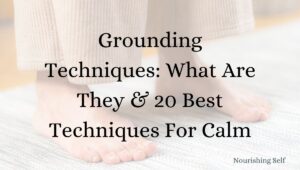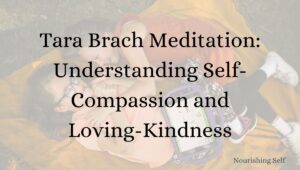
Cobra Pose Yoga: How To, Tips & Common Mistakes
Introduction
Among the many yoga poses, cobra pose (Bhujangasana) stands out as a powerful posture that strengthens the back, stretches the spine, and invigorates the body. Its name draws inspiration from the majestic cobra snake, known for its graceful movement and resilience.
Cobra pose is a foundational asana commonly practiced in Hatha and Vinyasa yoga styles. It engages not only the physical body but also deepens our mind-body connection by stimulating vital energy flow throughout our being.
By assuming this pose regularly, we can tap into our inner reserves of strength and flexibility while experiencing profound relaxation. As we delve into exploring cobra pose further, it is important to understand its origins within yogic tradition. The pose also symbolizes awakening and rebirth – qualities associated with shedding old patterns to embrace personal growth.
We’ll cover:
- What Muscles Are Involved?
- Step-By-Step Instructions
- Variations
- Common Mistakes
- Beginner’s Tips
What Muscles Are Involved?
Cobra pose, also known as Bhujangasana in Sanskrit, is a fundamental yoga posture that is often practiced as part of the Sun Salutation sequence.
It is a simple yet powerful backbend that offers numerous physical and mental benefits. The pose gets its name from the cobra, as it resembles the snake lifting its head and spreading its hood.
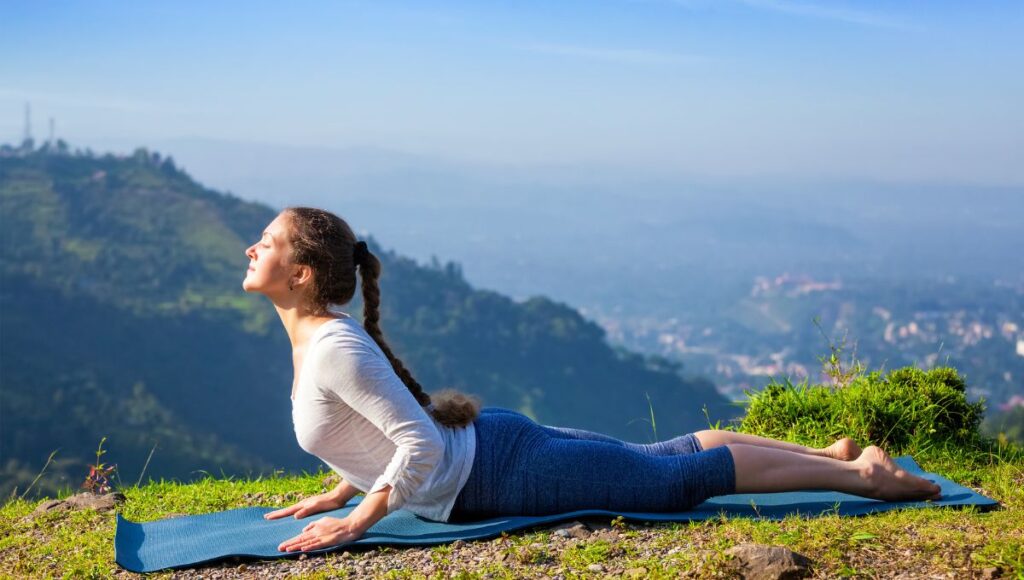
Understanding which muscles are involved can help practitioners better appreciate the benefits and importance of incorporating cobra pose into their yoga practice. The primary focus of the pose is to strengthen and stretch the muscles in the back.
The erector spinae muscles, found on either side of the spine from the sacrum all the way up to the base of the skull, play a significant role in achieving extension during this pose. These deep muscles help lift and lengthen the spine while maintaining stability throughout the movement.
Additionally, engaging these muscles aids in improving posture and relieving tension caused by prolonged sitting or poor spinal alignment.
In addition to targeting the erector spinae, cobra pose also engages several other muscle groups in both the upper and lower body.
The abdominals, including the rectus abdominis (commonly known as “six-pack” abs) and obliques, assist in supporting and stabilizing the lower back during backbends like cobra pose. Strengthening these core muscles helps maintain proper alignment and prevent excessive strain on other areas of your body.
Practicing cobra pose activates various upper body muscle groups such as deltoids (shoulders), trapezius (upper back), pectoralis major (chest), and biceps brachii (front part of upper arm). These muscles work together to provide support while opening up through chest expansion and shoulder stabilization during this backward bending posture.
Cultivating awareness of these engaged muscles not only facilitates correct alignment but also enables yogis to experience the full benefits of this asana, such as improved spinal flexibility, enhanced posture, and increased strength throughout the back and core regions.
Step-By-Step Instructions
To perform the invigorating and transformative cobra pose, follow these step-by-step instructions:
1. Starting Position
Lie flat on your stomach with your legs extended behind you.
Place your palms on the mat, aligned with your shoulders, fingers spread wide. Press the tops of your feet into the ground, ensuring that they are hip-width apart.
Engage your core muscles by drawing your navel towards your spine.
2. Preparing for Lift-off
As you inhale deeply, gently begin to lift your head and chest off the mat by pressing down through your hands and forearms. Keep a slight bend in your elbows to avoid hyperextension.
Ensure that you maintain a strong connection between your pubic bone and the mat throughout the pose.
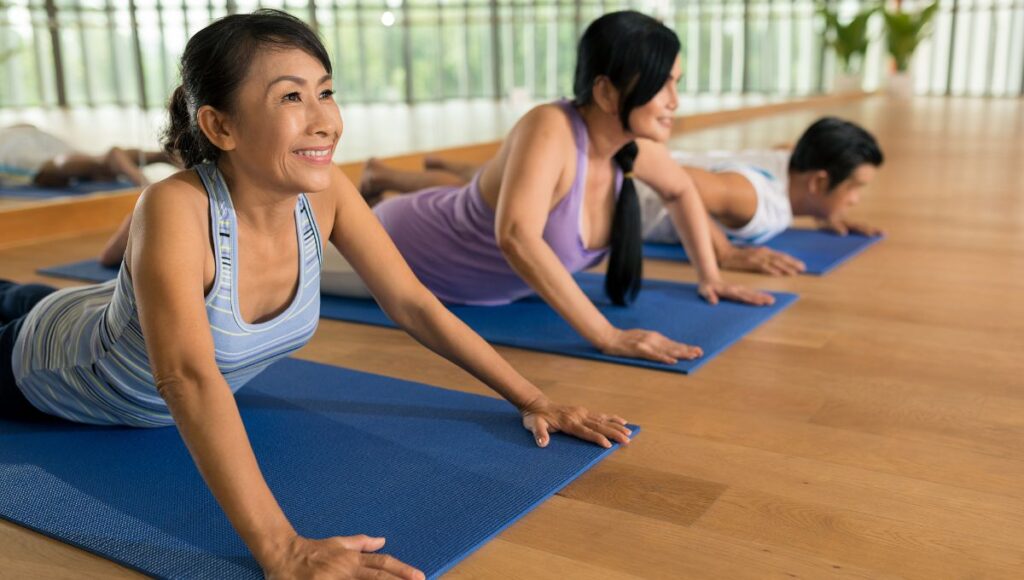
3. Lift Higher
With each exhale, gradually increase the height at which you lift yourself up while maintaining control and stability.
Continue to engage both the muscles in your back and core as you extend through the crown of your head.
4. Elongate Your Neck
To avoid straining or compressing the neck, elongate it by lengthening both sides evenly rather than craning it upwards excessively or dropping it too low.
This action helps maintain alignment in cobra pose and reduces potential discomfort.
5. Broaden Your Collarbones
While in cobra pose, focus on widening and opening across your collarbones to enhance both chest expansion and spinal flexibility. Imagine drawing each shoulder blade toward its corresponding hip to encourage this expansive sensation.
6. Breathe Deeply
Allow a steady flow of breath throughout this pose—inhaling as you prepare for lift-off, exhaling as you ascend further into cobra pose—enabling a sense of calmness within each movement.
Remember that Cobra Pose should be practiced with mindfulness, honoring any limitations or restrictions within one’s body while still exploring its potential benefits when performed correctly.
Variations
1. Sphinx Pose
Sphinx pose is a modified version of cobra pose that offers a gentler backbend while still providing similar benefits.
To practice this variation, start by lying on your stomach with your legs extended behind you. Place your forearms on the mat, keeping them parallel to each other and shoulder-width apart.
Press through your forearms and lift your chest off the ground, maintaining a slight curve in your lower back. Keep your gaze forward and breathe deeply as you hold this pose for several breaths.
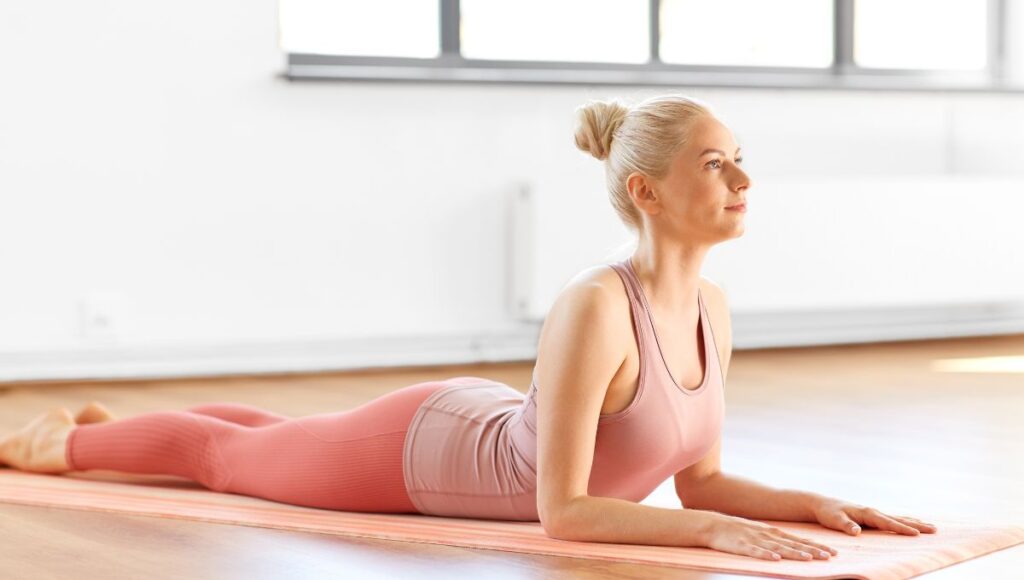
2. Upward-Facing Dog
Upward-facing dog is an intermediate variation that enhances the benefits of cobra pose by engaging additional muscle groups and increasing flexibility in the spine, shoulders, and wrists.
Begin in a prone position with palms facing down near the middle of your ribs. Press firmly through your hands and lift your chest off the mat, straightening both arms fully while keeping legs active and engaged.
Roll onto the tops of your feet to lift knees off the ground and bring thighs slightly upward. Open up through the front of the body by drawing shoulders down away from ears and looking forward or slightly upward.
3. One-Legged Cobra
One-legged cobra is an advanced variation that adds an element of balance and increased back strength to cobra pose.
Start in regular cobra pose position with both legs extended on the mat behind you, feet hip-width apart. As you inhale, engage your core muscles and slowly raise one leg off the ground while keeping it straight.
Hold this position for a few breaths, maintaining stability through strong arm alignment and engaging glutes for support before gently lowering it back down to meet its counterpart on the mat. Repeat with the opposite leg.
These variations not only provide new challenges but also target different muscles within similar movement patterns as traditional cobra pose yoga, allowing practitioners to deepen their practice at their own pace while experiencing diverse physical and mental benefits.
Common Mistakes
As a yoga teacher, these are some common mistakes that I see in my classes:
1. Improper Alignment
One of the most common mistakes people make in cobra pose is improper alignment. Many practitioners tend to push their hands too far forward, causing their shoulders to hunch up towards their ears.
This misalignment can put unnecessary strain on the lower back, leading to discomfort or even injury. To avoid this mistake, ensure that your hands are placed directly under your shoulders, with your fingers spread wide and pointing forward.
Keeping a slight bend in your elbows will also help maintain proper alignment throughout the pose.
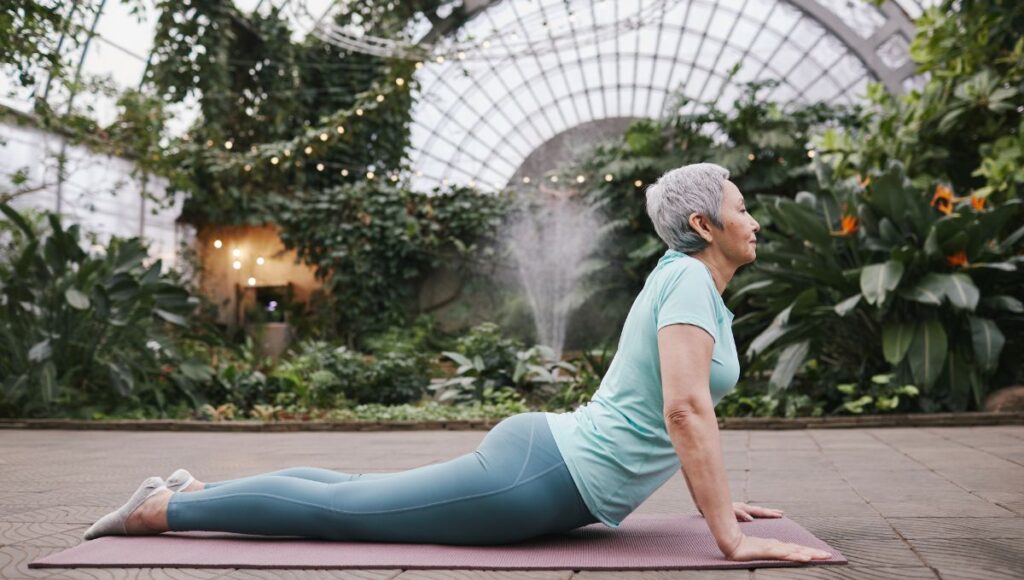
2. Lifting The Chin High
Another common misalignment is lifting the chin too high while coming into cobra pose.
When you lift your chin excessively, you put excessive pressure on the neck and compress the cervical spine. To prevent this mistake, imagine lengthening the back of your neck by gently tucking your chin slightly towards your chest as you lift into cobra pose.
3. Overuse of Back Muscles
Another common error individuals make in cobra pose is relying solely on their back muscles to lift their chest off the ground without engaging their core and leg muscles.
This can lead to straining and overworking of the back muscles, potentially resulting in discomfort or even muscle strains. To avoid this mistake, activate and engage not just your back muscles but also your core and leg muscles.
To ensure proper engagement of these muscle groups, start by pressing down through your hands and extending through your fingertips while keeping a gentle engagement in both pelvic floor and abdominal muscles.
Additionally, think about lengthening through both legs as you lift into cobra pose—this will distribute the effort more evenly across multiple muscle groups.
4. Holding Breath or Shallow Breathing
Many beginners tend to hold their breath or take shallow breaths during yoga poses like cobra pose due to a lack of awareness or unintentional tension buildup in the body.
Holding breath or shallow breathing restricts the flow of oxygen and energy, limiting the benefits of the pose and potentially causing unnecessary strain on the body. It’s vital to remember that breath should be continuous and flowing during any yoga practice.
To avoid this mistake, focus on maintaining a steady breath throughout cobra pose.
As you lift your chest off the ground, inhale deeply, allowing your lungs to expand fully.
Then, as you lower yourself back down, exhale slowly and completely.
This rhythmic breathing will not only help you stay relaxed but will also enhance the overall experience of cobra pose by fostering a sense of calmness and mindfulness.
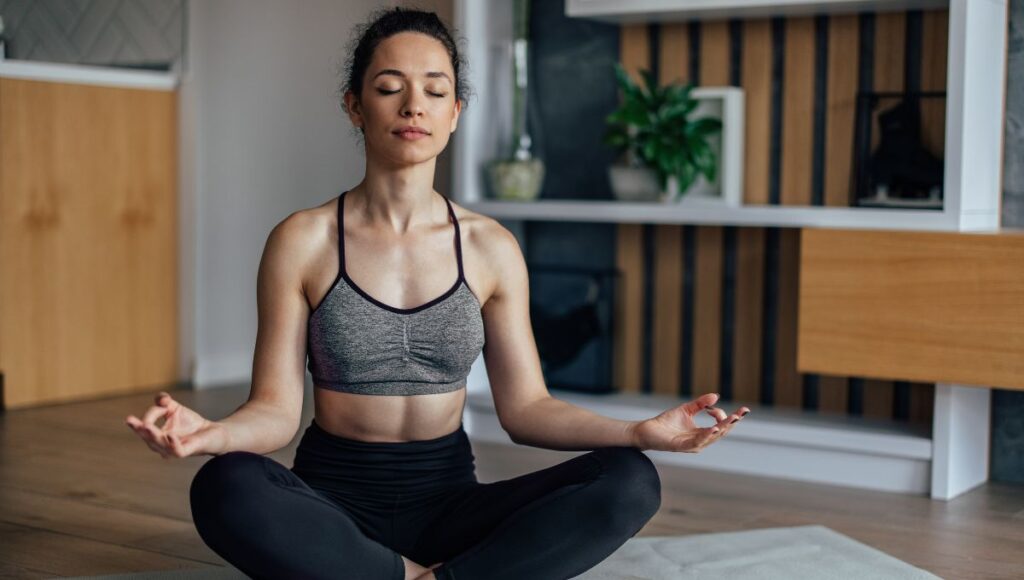
Beginner’s Tips
Gradual Progression
One of the key aspects of practicing cobra pose as a beginner is to progress gradually over time.
Start by lifting just a few inches off the ground and gradually increase this range of motion as you gain strength and flexibility in your back muscles.
Remember that Rome wasn’t built in a day, and neither will your ability to perform cobra pose.
Listen to your body’s signals and never push beyond what feels comfortable for you at any given moment.
Breathing Techniques
As we discussed earlier, breathing plays an essential role in any yoga practice, including cobra pose.
As a beginner, it is important to focus on synchronizing your breath with each movement during this posture.
Inhale deeply as you lift up into cobra pose, expanding the chest fully and allowing fresh oxygen to flow into those engaged muscles.
Exhale slowly as you lower back down towards the mat, releasing any tension or tightness accumulated during the previous phase of the pose.
This conscious breathing not only enhances relaxation but also helps promote greater body awareness throughout your practice.
Yoga Props
For beginners who may experience difficulty maintaining proper alignment or struggle with limited flexibility in their spine or wrists, utilizing yoga props can be immensely beneficial when practicing cobra pose yoga.
Placing a bolster beneath the hips can provide additional support and help maintain the natural curve of the lower back. Moreover, using blocks under your hands can bring the floor closer to you, reducing strain on your wrists.
Experimenting with props will enable beginners to find modifications that suit their unique needs, ensuring a safe and comfortable practice
Mindful Practice
Remember that cobra pose yoga is not just about physical movement; it is also an opportunity for mental and emotional growth. Cultivate mindfulness by bringing your attention to each aspect of the pose: how your body feels as it lifts and lowers, the sensations in your muscles, the quality of your breath.
Avoid rushing through the posture and instead embrace a slow and deliberate practice that allows you to fully connect with yourself in the present moment.
By approaching cobra pose with mindfulness, beginners can enhance their overall experience and deepen their connection to both body and mind.
Conclusion
Practicing cobra pose yoga can have significant benefits for both the mind and the body. The stretch provided by cobra pose also releases tension in the shoulders and neck, which is particularly beneficial for individuals who spend long hours sitting at a desk or working on computers.
This asana stimulates positive energy flow throughout the body, leaving practitioners feeling refreshed, rejuvenated, and ready to tackle any challenges that come their way. With proper guidance from a qualified yoga instructor or through consistent home practice with attention to alignment cues, cobra pose can be safely incorporated into any yoga routine.
As with any physical activity or exercise regimen, it is crucial to listen to your body’s limits and respect its boundaries to prevent injury. Incorporating cobra pose into your daily routine is an invitation to embrace your personal strength while promoting physical well-being.

